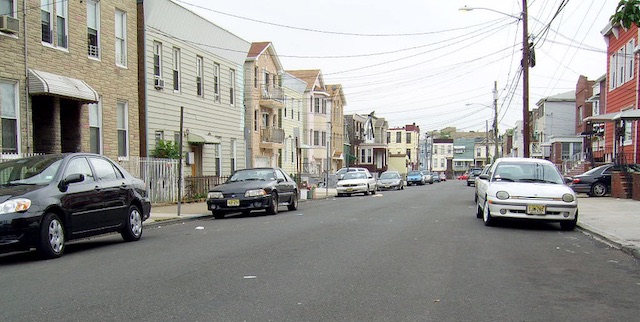In 2018, Jersey City adopted Vision Zero, the goal of reducing traffic fatalities to zero. In the past year, it had zero fatalities on city-owned streets. Mission accomplished!
A street in Jersey City. Photo by schokker64.
A Bloomberg article yesterday breathlessly reviewed all the things the city did to reduce fatalities to zero, including roundabouts, road diets, bike lanes, lower speed limits, and the closure of one street to automobiles. Yet there isn’t any real evidence that any of these steps contributed to reduced fatalities.
Most Jersey City traffic fatalities take place on state or county roads, and these haven’t particularly declined. According to the National Highway Traffic Safety Administration’s Fatality and Injury Reporting System Tool, counting city-owned streets only, there were 8 fatalities in 2017, 6 in 2018, and 2 in 2019. That makes it sound like adopting a Vision Zero policy reduced fatalities.
But there were zero fatalities on city streets in 2016. What was special about 2016? Nothing; it was just luck. After all, there were only 4 in 2015. Luck was probably the reason for zero fatalities over the past year as well. When there are so few annual fatalities on city streets, more than one year is needed before officials can declare victory.
This kind of sloppy thinking seems to be built into Vision Zero, which at heart is more of an anti-auto program than a pro-pedestrian or pro-safety program. Most pedestrian fatalities take place away from intersections at night, yet most pedestrian safety programs focus on intersections. In contrast, most bicycle fatalities take place at intersections, yet most bicycle safety programs focus on bike lanes away from intersections.
Another example of Vision Zero’s sloppy thinking can be found in a Minneapolis study. The city had put green paint on areas of ten intersections designated for cyclists. Two years later, they found that bicycle accidents had declined in four of the ten intersections, which the city considered a great success and justification for expanding the policy.
What they didn’t say was that bicycle accidents had increased at the other six intersections and, counting all ten intersections, there was an overall 21 percent increase in accidents. While the city earns a bonus point for looking at intersections for bike safety, officials were clearly looking at only the data that supported their preconceived view. The reality is that the green paint may have given the cyclists an illusion of safety leading them to engage in riskier behavior.
The entire Vision Zero program is based on a sloppy premise. It was developed in Sweden and proponents justify it by saying that Sweden’s roads see fewer fatalities per 100,000 residents than U.S. roads. But the Swedes also drive fewer than half as many miles per capita as Americans, so of course their fatalities per resident would be lower. Any program supported by such wrong-headed data should be seriously questioned.









Another failed attempt to improve cities from across the pond:
https://twitter.com/i/status/1608455265204019201